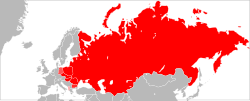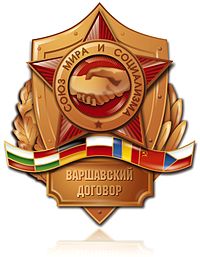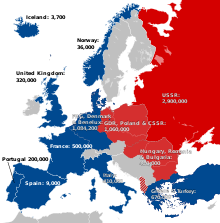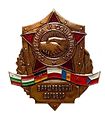Warsaw Pact: Difference between revisions
Iridescent (talk | contribs) m →Beginnings: Typo fixing, typo(s) fixed: Consequently → Consequently, using AWB |
|||
| Line 214: | Line 214: | ||
* [http://memory.loc.gov/frd/cs/soviet_union/su_appnc.html Library of Congress / Federal Research Division / Country Studies / Area Handbook Series / Soviet Union / Appendix C: The Warsaw Pact] (1989) |
* [http://memory.loc.gov/frd/cs/soviet_union/su_appnc.html Library of Congress / Federal Research Division / Country Studies / Area Handbook Series / Soviet Union / Appendix C: The Warsaw Pact] (1989) |
||
* {{loc}} |
* {{loc}} |
||
* [http://omniatlas.com/maps/russia/19550921/ Map of Russia and the Warsaw Pact (omniatlas.com)] |
|||
* [http://omniatlas.com/maps/europe/19550921/ Map of Europe and the Warsaw Pact (omniatlas.com)] |
|||
{{Clear}} |
{{Clear}} |
||
Revision as of 19:08, 21 September 2015
| Russian: Договор о дружбе, сотрудничестве и взаимной помощи | |
 | |
 Members of the Warsaw Pact | |
| Formation | 14 May 1955 |
|---|---|
| Type | Military alliance |
| Headquarters | Warsaw, Poland (Command and Control HQ) Moscow, Soviet Union (Military HQ) |
| Membership |
|
| Petr Lushev (last) | |
| Vladimir Lobov (last) | |
| Eastern Bloc |
|---|
 |

The Warsaw Pact (formally, the Treaty of Friendship, Co-operation, and Mutual Assistance, sometimes, informally WarPac, akin in format to NATO)[1] was a collective defense treaty among eight communist states of Central and Eastern Europe in existence during the Cold War, led by the USSR. The Warsaw Pact was the military complement to the Council for Mutual Economic Assistance (CoMEcon), the regional economic organization for the communist states of Central and Eastern Europe. The Warsaw Pact was in part a Soviet military reaction to the integration of West Germany[2] into NATO in 1955 per the Paris Pacts of 1954,[3][4][5] but was primarily motivated by Soviet desires to maintain control over military forces in Central and Eastern Europe;[6] in turn (according to the Warsaw Pact's preamble) meant to maintain peace in Europe, guided by the objective points and principles of the Charter of the United Nations (1945).
The Warsaw Pact's largest military engagements were aimed against its own members, in 1956 against Hungary and in 1968 against Czechoslovakia.
On 25 February 1991, the Pact was declared at an end in a meeting of defense and foreign ministers in Hungary. On 1 July 1991, the Czechoslovak President Václav Havel formally declared an end to the Warsaw Treaty Organization of Friendship, Co-operation, and Mutual Assistance which had been established in 1955.
Nomenclature

In the Western Bloc, the Warsaw Treaty Organization of Friendship, Cooperation, and Mutual Assistance is often called the Warsaw Pact military alliance—abbreviated WAPA, Warpac, and WP. Elsewhere, in the former member states, the Warsaw Treaty is known as:
- Template:Lang-al
- Template:Lang-bg
- Romanized Bulgarian: Dogovor za druzhba, satrudnichestvo i vzaimopomosht
- Template:Lang-cs
- Template:Lang-sk
- Template:Lang-de
- Template:Lang-hu
- Template:Lang-pl
- Template:Lang-ro
- Russian: Договор о дружбе, сотрудничестве и взаимной помощи
- Romanized Russian: Dogovor o druzhbe, sotrudnichestve i vzaimnoy pomoshchi
Structure
The Warsaw Treaty's organization was two-fold: the Political Consultative Committee handled political matters, and the Combined Command of Pact Armed Forces controlled the assigned multi-national forces, with headquarters in Warsaw, Poland. Furthermore, the Supreme Commander of the Unified Armed Forces of the Warsaw Treaty Organization which commands and controls all the military forces of the member countries was also a First Deputy Minister of Defense of the USSR, and the Chief of Combined Staff of the Unified Armed Forces of the Warsaw Treaty Organization was also a First Deputy Chief of the General Staff of the Armed Forces of the USSR. Therefore, although ostensibly an international collective security alliance, the USSR dominated the Warsaw Treaty armed forces.[7]
Strategy
The strategy behind the formation of the Warsaw Pact was driven by the desire of the Soviet Union to dominate Central and Eastern Europe. This policy was driven by ideological and geostrategic reasons. Ideologically, the Soviet Union arrogated the right to define socialism and communism and act as the leader of the global socialist movement. A corollary to this idea was the necessity of intervention if a country appeared to be violating core socialist ideas and Communist Party functions, which was explicitly stated in the Brezhnev Doctrine.[8] Geostrategic principles also drove the Soviet Union to prevent invasion of its territory by Western European powers, which had occurred most recently by Nazi Germany in 1941. The invasion launched by Hitler had been exceptionally brutal and the USSR emerged from the Second World War in 1945 with the greatest total casualties of any participant in the war (second in percentage of population loss after Poland), suffering an estimated 27 million killed (the population would not return to its pre-war level for 30 years[9]) along with the destruction of much of the nation's industrial capacity.[10]
History
Beginnings

In March 1954, the USSR, fearing "the restoration of German Militarism" in West Germany, requested admission to NATO.[11][12][13] By then, laws had already been passed in West Germany ending denazification [14][15] and the Gehlen Organization, predecessor of the West German Federal Intelligence Service, was fully operative and employing hundreds of ex-Nazis.[16]
The Western Germany request to join NATO arose in the aftermath of the Berlin Conference of January–February 1954. Soviet foreign minister Molotov made different proposals to have Germany reunified[17] and elections for a pan-German government,[18] under conditions of withdrawal of the four powers armies and German neutrality,[19] but all were refused by the other foreign ministers, Dulles (USA), Eden (UK) and Bidault (France).[20] Proposals for the reunification of Germany were nothing new: earlier on 20 March 1952, talks about a German reunification, initiated by the socalled 'Stalin Note', ended after the United Kingdom, France, and the United States insisted that a unified Germany should not be neutral and should be free to join the European Defence Community and rearm. James Dunn (USA), who met in Paris with Eden, Adenauer and Robert Schuman (France), affirmed that "the object should be to avoid discussion with the Russians and to press on the European Defense Community".[21] According to John Gaddis "there was little inclination in Western capitals to explore this offer" from USSR.[22] While historian Rolf Steininger asserts that Adenauer's conviction that “neutralization means sovietization” was the main factor in the rejection of the soviet proposals [23] as Adenauer feared that unification might result in the end of the CDU's dominance in the Bundestag.[24]
Consequently, Molotov, fearing that EDC would be directed in the future against the USSR therefore "seeking to prevent the formation of groups of European States directed against other European States",[25] made a proposal for a General European Treaty on Collective Security in Europe "open to all European States without regard as to their social systems"[25] which would have included the unified Germany (thus making the EDC – perceived by the USSR as a threat – unusable). But again, Eden, Dulles and Bidault opposed the proposal.[26]
One month later, the proposed European Treaty was rejected not only by supporters of the EDC but also by western opponents of the European Defense Community (like French Gaullist leader Palewski) who perceived it as "unacceptable in its present form because it excludes the USA from participation in the collective security system in Europe".[27] The Soviets then decided to make a new proposal to the governments of the USA, UK and France stating to accept the participation of the USA in the proposed General European Agreement.[27] And considering that another argument deployed against the Soviet proposal was that it was perceived by western powers as "directed against the North Atlantic Pact and its liquidation",[27][28] the Soviets decided to declare their "readiness to examine jointly with other interested parties the question of the participation of the USSR in the North Atlantic bloc", specifying that "the admittance of the USA into the General European Agreement should not be conditional on the three western powers agreeing to the USSR joining the North Atlantic Pact".[27]
Again all proposals, including the request to join NATO, were rejected by UK, US, and French governments shortly after.[13][29] Emblematic was the position of British General Hastings Ismay, supporter of NATO expansion, who said that NATO "must grow until the whole free world gets under one umbrella."[30] He opposed the request to join NATO made by the USSR in 1954[31] saying that "the Soviet request to join NATO is like an unrepentant burglar requesting to join the police force".[32]
In April 1954 Adenauer made his first visit to the USA meeting Nixon, Eisenhower and Dulles. Ratification of EDC was delaying but the US representatives made it clear to Adenauer that EDC would have to become a part of NATO.[33]
Memories of the Nazi occupation were still strong, and the rearmament of Germany was feared by France too.[34] On 30 August 1954 French Parliament rejected the EDC, thus ensuring its failure[35] and blocking a major objective of US policy towards Europe: to associate Germany militarily with the West.[36] The US Department of State started to elaborate alternatives: Germany would be invited to join NATO or, in the case of French obstructionism, strategies to circumvent a French veto would be implemented in order to obtain a German rearmament outside NATO.[37]
On 23 October 1954 – only nine years after Allies (UK, USA and USSR) defeated Nazi Germany ending World War II in Europe – the Federal Republic of Germany was finally admitted to the North Atlantic Pact. The incorporation of West Germany into the organization on 9 May 1955 was described as "a decisive turning point in the history of our continent" by Halvard Lange, Foreign Affairs Minister of Norway at the time.[38]

On 14 May 1955, the USSR and other seven European countries "reaffirming their desire for the establishment of a system of European collective security based on the participation of all European states irrespective of their social and political systems"[39] established the Warsaw Pact in response to the integration of the Federal Republic of Germany into NATO, declaring that: "a remilitarized Western Germany and the integration of the latter in the North-Atlantic bloc [...] increase the danger of another war and constitutes a threat to the national security of the peaceable states; [...] in these circumstances the peaceable European states must take the necessary measures to safeguard their security".[39]
One of the founding members, East Germany was allowed to re-arm by the Soviet Union and the National People's Army was established as the armed forces of the country to counter the rearmament of West Germany.
Members
This article needs additional citations for verification. (December 2014) |
The eight member countries of the Warsaw Pact pledged the mutual defense of any member who would be attacked. Relations among the treaty signatories were based upon mutual non-intervention in the internal affairs of the member countries, respect for national sovereignty, and political independence. However, almost all governments of those member states were indirectly controlled by the Soviet Union.
The founding signatories to the Treaty of Friendship, Cooperation and Mutual Assistance consisted of the following communist governments:
 People's Republic of Albania (withheld support in 1961 because of the Sino–Soviet split, formally withdrew in 1968)
People's Republic of Albania (withheld support in 1961 because of the Sino–Soviet split, formally withdrew in 1968) People's Republic of Bulgaria
People's Republic of Bulgaria Czechoslovak Republic (Czechoslovak Socialist Republic since 1960)
Czechoslovak Republic (Czechoslovak Socialist Republic since 1960) German Democratic Republic (withdrew in September 1990, before German reunification)
German Democratic Republic (withdrew in September 1990, before German reunification) People's Republic of Hungary
People's Republic of Hungary People's Republic of Poland (withdrew on 1 January 1990)
People's Republic of Poland (withdrew on 1 January 1990) People's Republic of Romania (after 1965 the Socialist Republic of Romania)
People's Republic of Romania (after 1965 the Socialist Republic of Romania) Union of Soviet Socialist Republics
Union of Soviet Socialist Republics
In July 1963 the Mongolian People's Republic asked to join the Warsaw Pact under Article 9 of the treaty. For this purpose a special protocol should have been taken since the text of the treaty applied only to Europe. Due to the emerging Sino-Soviet split, Mongolia remained on observer status. Soviet stationing troops were agreed to stay in Mongolia from 1966.
During Cold War
This article needs additional citations for verification. (December 2014) |
For 36 years, NATO and the Warsaw Pact never directly waged war against each other in Europe; the United States and the Soviet Union and their respective allies implemented strategic policies aimed at the containment of each other in Europe, while working and fighting for influence within the wider Cold War on the international stage.
In 1956, following the declaration of the Imre Nagy government of withdrawal of Hungary from the Warsaw Pact, Soviet troops entered the country and removed the government. Soviet forces crushed the nationwide revolt, leading to the death of an estimated 2,500 Hungarian citizens.
The multi-national Communist armed forces' sole joint action was the Warsaw Pact invasion of Czechoslovakia in August 1968. All member countries, with the exception of the Socialist Republic of Romania and the People's Republic of Albania participated in the invasion.
End of the Cold War
Beginning at the Cold War's conclusion, in late 1989, popular civil and political public discontent forced the Communist governments of the Warsaw Treaty countries from power, while independent national politics made feasible with the perestroika and glasnost induced institutional collapse of Communist government in the USSR.[40]
In December 1989, a revolution in Romania brought down the communist government there and ended Romania's Pact membership, and in October 1990 East Germany also left the Pact, as a result of German reunification.
Eventually, Communist governments in the period from 1989–91 were deposed in Hungary, Czechoslovakia, East Germany, Poland, Romania and Bulgaria.
On 25 February 1991, the Warsaw Pact was declared disbanded at a meeting of defense and foreign ministers from remaining Pact countries meeting in Hungary.[41] On 1 July 1991, in Prague, the Czechoslovak President Václav Havel formally ended the 1955 Warsaw Treaty Organization of Friendship, Cooperation, and Mutual Assistance and so disestablished the Warsaw Treaty after 36 years of military alliance with the USSR.[42] In fact, the treaty was de facto disbanded in December 1989 during the violent revolution in Romania that toppled the communist government there. The USSR disestablished itself in December 1991.
Central and Eastern Europe after the Warsaw Treaty
On 12 March 1999, the Czech Republic, Hungary, and Poland joined NATO; Bulgaria, Estonia, Latvia, Lithuania, Romania, and Slovakia joined in March 2004; Albania joined on 1 April 2009.
Russia and some other post-USSR states joined in the Collective Security Treaty Organisation (CSTO).
In November 2005, the Polish government opened its Warsaw Treaty archives to the Institute of National Remembrance, who published some 1,300 declassified documents in January 2006. Yet the Polish government reserved publication of 100 documents, pending their military declassification. Eventually, 30 of the reserved 100 documents were published; 70 remained secret, and unpublished. Among the documents published is the Warsaw Treaty's nuclear war plan, Seven Days to the River Rhine – a short, swift counter-attack capturing Austria, Denmark, Germany and Netherlands east of River Rhine, using nuclear weapons, in self-defense, after a NATO first strike. The plan originated as a 1979 field training exercise war game, and metamorphosed into official Warsaw Treaty battle doctrine, until the late 1980s – which is why the People's Republic of Poland was a nuclear weapons base, first, to 178, then, to 250 tactical-range rockets. Doctrinally, as a Soviet-style (offensive) battle plan, Seven Days to the River Rhine gave commanders few defensive-war strategies for fighting NATO in Warsaw Treaty territory.[citation needed]
Gallery
-
Badge Warsaw Pact. Union of peace and socialism
-
Badge Warsaw Pact. Brothers in arms (1970)
-
Badge A participant in joint exercises of Warsaw Pact "STIT" (1972)
-
Badge 25 years Warsaw Pact (1980)
-
AIR FORCE air forces Warsaw Pact
-
Badge Warsaw Pact. The participants of the joint exercises in Bulgaria (1982)
-
Jubilee badge 30 years of the Warsaw Pact (1985)
See also
- Collective Security Treaty Organization (CSTO) - Modern military alliance between former Soviet states.
- Shanghai Cooperation Organisation (SCO) - Modern Eurasian political, economic and military organisation.
References
- ^ "Text of Warsaw Pact" (PDF). United Nations Treaty Collection. Retrieved 22 August 2013.
- ^ Yost, David S. (1998). NATO Transformed: The Alliance's New Roles in International Security. Washington, DC: U.S. Institute of Peace Press. p. 31. ISBN 1-878379-81-X.
- ^ Broadhurst, Arlene Idol (1982). The Future of European Alliance Systems. Boulder, Colorado: Westview Press. p. 137. ISBN 0-86531-413-6.
- ^ Christopher Cook, Dictionary of Historical Terms (1983)
- ^ The Columbia Enclopedia, fifth edition (1993) p. 2926
- ^ "Warsaw Pact: Wartime Status-Instruments of Soviet Control". Wilson Center. Retrieved 5 October 2013.
- ^ Fes'kov, V. I.; Kalashnikov, K. A.; Golikov, V. I. (2004). Sovetskai͡a Armii͡a v gody "kholodnoĭ voĭny," 1945–1991. Tomsk: Tomsk University Publisher. p. 6. ISBN 5-7511-1819-7.
{{cite book}}: Unknown parameter|trans_title=ignored (|trans-title=suggested) (help) - ^ ' 'The Review of Politics Volume' ', 34, No. 2 (April 1972), pp. 190-209
- ^ "20m Soviet war dead may be underestimate”, Guardian, 30 April 1994 quoting Professor John Erickson of Edinburgh University, Defence Studies.
- ^ Glenn E. Curtis, ed. Russia: A Country Study, Washington: Library of Congress, 1996
- ^ "Soviet Union request to join NATO" (PDF). Nato.int. Retrieved 31 July 2013.
- ^ "Fast facts about NATO". CBC News. 6 April 2009. Retrieved 16 July 2011.
- ^ a b "Proposal of Soviet adherence to NATO as reported in the Foreign Relations of the United States Collection". UWDC FRUS Library. Retrieved 31 July 2013.
- ^ Art, David, The Politics of the Nazi Past in Germany and Austria, Cambridge: Cambridge University Press, 2005, pp. 53-55
- ^ Wahl 2007, p. 92-108.
- ^ Höhne, Heinz; Zolling, Hermann, The General Was a Spy: The Truth about General Gehlen and His Spy Ring, New York: Coward, McCann & Geoghegan 1972, p. 31
- ^ Molotov 1954a, p. 197,201.
- ^ Molotov 1954a, p. 202.
- ^ Molotov 1954a, p. 197–198, 203, 212.
- ^ Molotov 1954a, p. 211–212, 216.
- ^ Steininger, Rolf (1991). The German Question: The Stalin Note of 1952 and the Problem of Reunification. Columbia Univ Press. p. 56.
- ^ Gaddis, John (1997). We Know Now: Rethinking Cold War History. Clarendon Press. p. 126.
- ^ Steininger, Rolf (1991). The German Question: The Stalin Note of 1952 and the Problem of Reunification. Columbia Univ Press. p. 80.
- ^ Steininger, Rolf (1991). The German Question: The Stalin Note of 1952 and the Problem of Reunification. Columbia Univ Press. p. 103.
- ^ a b "Draft general European Treaty on collective security in Europe — Molotov proposal (Berlin, 10 February 1954)" (PDF). CVCE. Retrieved 1 August 2013.
- ^ Molotov 1954a, p. 214.
- ^ a b c d "MOLOTOV'S PROPOSAL THAT THE USSR JOIN NATO, MARCH 1954". Wilson Center. Retrieved 1 August 2013.
- ^ Molotov 1954a, p. 216,.
- ^ "Final text of tripartite reply to Soviet note" (PDF). Nato website. Retrieved 31 July 2013.
- ^ Jordan, p. 65
- ^ http://www.guardian.co.uk/world/2001/jun/17/russia.iantraynor
- ^ "Memo by Lord Ismay, Secretary General of NATO" (PDF). Nato.int. Retrieved 31 July 2013.
- ^ Adenauer 1966a, p. 662.
- ^ "The refusal to ratify the EDC Treaty". CVCE. Retrieved 1 August 2013.
- ^ "Debates in the French National Assembly on 30 August 1954". CVCE. Retrieved 1 August 2013.
- ^ "US positions on alternatives to EDC". United States Department of State / FRUS collection. Retrieved 1 August 2013.
- ^ "US positions on german rearmament outside NATO". United States Department of State / FRUS collection. Retrieved 1 August 2013.
- ^ "West Germany accepted into Nato". BBC News. 9 May 1955. Retrieved 17 January 2012.
- ^ a b "Text of the Warsaw Security Pact (see preamble)". Avalon Project. Retrieved 31 July 2013.
- ^ The New Fontana Dictionary of Modern Thought, third edition, 1999, pp. 637–8
- ^ "Warsaw Pact and Comecon To Dissolve This Week". Csmonitor.com. 26 February 1991. Retrieved 4 June 2012.
- ^ Havel, Václav (2007). To the Castle and Back. Trans. Paul Wilson. New York: Alfred A. Knopf. ISBN 978-0-307-26641-5.
Further reading
- Faringdon, Hugh. Confrontation: the strategic geography of NATO and the Warsaw Pact. (London: Routledge & Kegan Paul, 1986.)
- Heuser, Beatrice (1998). "Victory in a Nuclear War? A Comparison of NATO and WTO War Aims and Strategies". Contemporary European History. 7 (3): 311–327. doi:10.1017/S0960777300004264.
- Mackintosh, Malcolm. The evolution of the Warsaw Pact (International Institute for Strategic Studies, 1969)
- Kramer, Mark N. "Civil-military relations in the Warsaw Pact, The East European component," International Affairs, Vol. 61, No. 1, Winter 1984-85.
- Lewis, William Julian (1982). The Warsaw Pact: Arms, Doctrine, and Strategy. Cambridge, Mass.: Institute for Foreign Policy Analysis. ISBN 978-0-07-031746-8.
- Mastny, Vojtech; Byrne, Malcolm (2005). A Cardboard Castle ?: An Inside History of the Warsaw Pact, 1955–1991. Budapest: Central European University Press. ISBN 978-963-7326-07-3.
Other languages
- Umbach, Frank (2005). Das rote Bündnis: Entwicklung und Zerfall des Warschauer Paktes 1955 bis 1991 (in German). Berlin: Ch. Links Verlag. ISBN 978-3-86153-362-7.
- Wahl, Alfred (2007). La seconda vita del nazismo nella Germania del dopoguerra (in Italian). Torino: Lindau. ISBN 978-8-87180-662-4. – Original Ed.: Wahl, Alfred (2006). La seconde histoire du nazisme dans l'Allemagne fédérale depuis 1945 (in French). Paris: Armand Colin. ISBN 2-200-26844-0.
Memoirs
- Adenauer, Konrad (1966b). Konrad Adenauer Memoirs 1945-53. Henry Regnery Company.
- Molotov, Vyacheslav (1954b). Statements at Berlin Conference of Foreign Ministers of U.S.S.R., France, Great Britain and U.S.A., January 25-February 18, 1954. Foreign Languages Publishing House.
Memoirs (Other languages)
- Adenauer, Konrad (1966a). Memorie 1945-1953 (in Italian). Arnoldo Mondadori Editore.
- Molotov, Vyacheslav (1954a). La conferenza di Berlino (in Italian). Ed. di cultura sociale.
External links
- The Woodrow Wilson Center Cold War International History Project's Warsaw Pact Document Collection[dead link]
- Parallel History Project on Cooperative Security
- Library of Congress / Federal Research Division / Country Studies / Area Handbook Series / Soviet Union / Appendix C: The Warsaw Pact (1989)

This image is available from the United States Library of Congress Prints and Photographs Division under the digital ID {{{id}}}
This tag does not indicate the copyright status of the attached work. A normal copyright tag is still required. See Wikipedia:Copyrights for more information.
- Map of Russia and the Warsaw Pact (omniatlas.com)
- Map of Europe and the Warsaw Pact (omniatlas.com)
- Warsaw Pact
- Eastern Bloc
- 1991 in politics
- 20th-century military alliances
- Bulgaria–Soviet Union relations
- Cold War treaties
- Communism
- Foreign relations of the Soviet Union
- Former international organizations
- Germany–Soviet Union relations
- History of Poland (1989–present)
- History of Warsaw
- International military organizations
- International political organizations
- Military alliances involving Bulgaria
- Military alliances involving Czechoslovakia
- Military alliances involving Hungary
- Military alliances involving Poland
- Military alliances involving Romania
- Military alliances involving the Soviet Union
- Modern Europe
- Organizations established in 1955
- Organizations disestablished in 1991
- Poland–Soviet Union relations
- Treaties concluded in 1955
- Treaties entered into force in 1955
- Treaties of East Germany
- Treaties of the People's Republic of Bulgaria
- Treaties of the Hungarian People's Republic
- Treaties of the Polish People's Republic
- Treaties of the People's Socialist Republic of Albania
- Treaties of the Socialist Republic of Romania
- Czechoslovakia–Soviet Union relations
- Hungary–Soviet Union relations
- Treaties establishing intergovernmental organizations
- Cold War terminology









